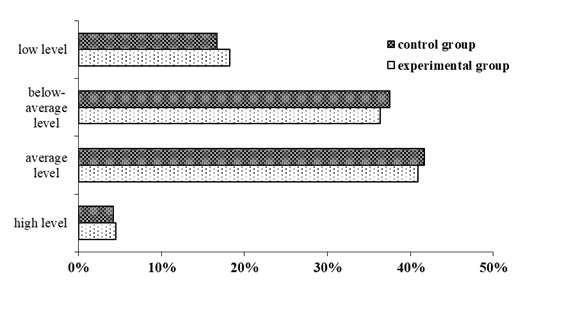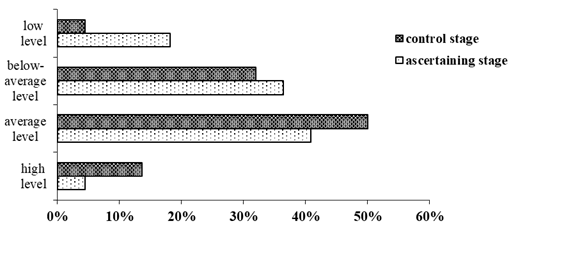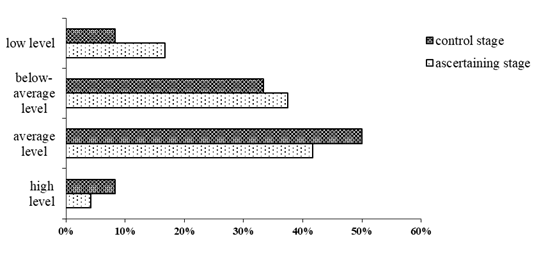Abstract
The article is devoted to the methodological aspects of developing personal protective equipment (PPE) skills while teaching health and safety and substantiating effective engagement of senior high school students in practical activities in this area using a flipped learning model. In the current context, large-scale works to save the environment of the Earth carried out as part of the disarmament policy, elimination of nuclear and chemical weapon can lead to accidents and incidents with emission of chemically hazardous and radioactive substances that can be harmful to human life and health. The aim is to study the development of PPE skills using a flipped classroom while teaching health and safety. The article presents an analysis of key indicators showing the flipped classroom strategy efficiency. We considered the general issues of preparing school students for survival in the face of anthropogenic hazards and developing the personality able to behave safely. We substantiated the necessity to spend, during health and safety lessons, more time on practical teaching methods that will develop students’ PPE skills more effectively. We offered the approaches to teaching health and safety, proved the flipped classroom strategy efficiency.
Keywords: Learning process, flipped classroom, blended learning, practical activities, personal protective equipment
Introduction
A flipped learning approach is gaining popularity in the education system. The flipped learning model transfers the delivery of knowledge into a student’s private environment and allocates more time for practical skills. This strategy (Flipped Classroom) is comparatively new, developed by Jonathan Bergmann and Aaron Sams as a learning process model, filling the shortage of class hours for students majoring in physical education (Bergmann & Sams, 2012, 2014). Flipped learning creates opportunities to solve complex pedagogical issues in the education system. On the one hand, teachers can work individually with students having different competence levels. On the other hand, teachers can organize joint teamwork on the projects in a classroom.
Flipped learning as a learning strategy suggests that students must listen to and watch video lessons using gadgets, study additional sources using electronic resources outside the classroom. Then they should discuss new concepts and various ideas with a teacher in the classroom to consolidate new knowledge and learn to put it into practice. Such classes can become a tool for teachers to create their blended classroom using diverse techniques and methods of blended learning (Litvinova, 2015).
In the current context, large-scale works to save the environment of the Earth carried out as part of the disarmament policy, elimination of nuclear and chemical weapon can lead to accidents and incidents with emission of chemically hazardous and radioactive substances that can be harmful to human life and health.
Besides, there are many radiation- and chemically hazardous facilities in Russia. Therefore, the issues of population protection in emergencies related to accidents at these facilities are also urgent. Nature increasingly demonstrates its destructive forces, with a growing number of industrial accidents and disasters, acts of sabotage, terrorist attacks, hazardous social situations, showing that people lack sufficient behavioral safety skills in everyday life. Therefore, we must prepare the population for protection from chemically hazardous and radioactive substances. In this respect, the use of PPE plays a crucial role in the general system of population protection in an emergency. The population category that should change its attitude towards personal security is the younger generation. It is the most "vulnerable community" (Obukhova, 2010). For this purpose, we must teach the population to use PPE, and it is reasonable to start teaching it from school days. The Health and Safety school course that not only familiarizes students with personal protective equipment but teaches how to use it (Aizman & Korolev, 2012) can be of great help. The main objective of the Health and Safety course taught for many years in school is to build children and adolescents' safe behavior skills, develop their knowledge and abilities to behave in an emergency correctly. However, safe behavior as personal demonstration is not developed only based on the information obtained (Kodzhaspirov et al., 2019). Previously, we showed that the educational process efficiency depends on teachers’ abilities and possibilities to use all kinds of classes and learning activities (Polozova et al., 2017; Zimina et al., 2017). During the studies, we must not only familiarize students with PPE used in man-caused emergencies. We must also teach them to use it. Based on the above, it is interesting to study the experience of using flipped classrooms for more effective development of school students’ PPE skills. This strategy “is successfully developing, presents a promising approach and type of blended learning” (Voronina, 2018, p. 40). Teachers already use it for teaching foreign languages, mathematics, handicraft, etc. As shown by Yanchenko (2016), the advantages of the strategy under study are as follows: increased study motivation, a transparent learning path when studying the subject and assessing learning outcomes, a possibility to implement a learner-centered approach, the development of soft skills in the field of electronic communications necessary for lifelong learning.
Problem Statement
We put forward an assumption that the development of senior high school students’ PPE skills would be more effective if we minimized the amount of time spent on giving the theory during health and safety lessons. We should give it to senior high school students for independent study, thus engaging them in practical activities.
Research Questions
- The necessity of teaching PPE rules to school students.
- The change in the younger generation’s attitude towards personal security.
- The role of a flipped classroom in the efficient process of developing school students’ PPE skills.
Purpose of the Study
The study aimed to investigate and develop students’ practical PPE skills while teaching health and safety using the flipped classroom strategy.
Research Methods
The article presents an analysis of key indicators showing the flipped classroom strategy efficiency.
We used statistical methods while processing the experimental data.
Findings
As a trial facility, we used Berezovo comprehensive secondary school (Russia).
The theoretical and practical relevance of the study:
- analysis of the methodological aspects of the development of PPE skills while teaching health and safety;
- substantiation of the efficiency of engaging senior high school students in practical activities in this area.
While studying PPE during health and safety lessons, students must spend more time on practical tasks. They will help them more effectively develop their PPE skills. They will better memorize the appearance and structure of PPE, will be able to polish skills of putting on a gas mask and making a gauze and cotton dressing, etc.
In the experimental part of our study, we determined the level of senior high school students’ PPE skills (Figure 1).

Only 5% and 4% of school students from the experimental and control groups, respectively, demonstrated a high level. We also noted that most senior high school students showed average and below-average levels equivalent to grades “good” and “pass.” In the experimental grade, 41% of school students showed an average level, 36% had a below-average level. In the control grade, 42% of school students had an average level, 38% had a below-average level. Unfortunately, some students in both grades: 18% (the experimental group) and 17% (the control group) failed the task, which corresponds to a low level of PPE skills.
Most health and safety lessons on PPE given in both groups were traditional. We conducted them using the textbook and its illustrations, and there were few practical tasks for developing PPE skills. Therefore, we can assume that practical classes on this topic will contribute to the successful development of PPE skills.
During the educational experiment, we developed and conducted the following lessons to develop PPE skills in the experimental group: a lesson on the topic "Personal protective equipment;" a lesson on the topic "Personal protective equipment for population, their intended use;" and a homeroom period on how to use PPE.
In the control group, we conducted lessons on this topic using textbook illustrations without doing practical tasks.
Modern teachers are in constant search of new tools for making the explanation and feedback processes more lively. They aim to make all students more active, heighten their interest in classes, and accelerate memorization, comprehension, and acquisition processes. One of such tools is a flipped classroom that inverts traditional teaching methods. It delivers instruction outside the classroom and moves homework into the classroom.
Due to the lack of academic hours for studying PPE, we conducted the flipped health and safety lessons to give students the theory for independent study and then engage them in practical classroom activities instead of dull note-taking.
Besides the lessons, we conducted a homeroom period where the school students competed with the staff members of the Ministry of Emergency Situations in putting on a gas mask and PPE. Students had many positive emotions and polished their PPE skills. Then students prepared a lesson on PPE for junior school students. They made a presentation, demonstrated PPE, showed practical actions, and taught fifth-graders to make a gauze and cotton dressing.
At the end of the formative experiment, the experimental grade students put on gas masks and made and used PPE for assessment. A total of 41% of school students got excellent grades. The other 59% of tenth-graders got good grades.
To determine the efficiency of developing school students’ PPE skills, we conducted a retest (Figure 2, 3).

According to the submitted data, many students scored more points for accomplished tasks even if their skill level remained unchanged. Thus, the number of students with high and average levels of PPE skills increased by 9%. The number of students with a below-average level decreased by 4%, and the number of students with a low level decreased by 13% (Figure 2).

The results of the control stage of the control grade experiment were as follows: the number of students with a high level of PPE skills increased by 4%; the number of students with an average level increased by 8%; the number of students with a below-average level decreased by 5%, and the number of students with a low level decreased by 9% (Figure 3).
Thus, the control class also demonstrates positive trends in developing PPE skills. Nevertheless, the figures are lower compared to those in the experimental grade.
A comparison of the control experiment results in the experimental and control groups showed that the number of students with a high level was 5% higher than in the control group. The number of students with a low level was 4% lower. Consequently, we confirmed our hypothesis that the development of senior high school students' PPE skills would be more successful if we minimized the time spent on giving the theory and engage students in practical activities.
Conclusion
At the ascertaining stage of the study, only 5% and 4% of school students in the experimental and control groups, respectively, demonstrated a high level. Most senior high school students showed average and below-average levels equivalent to grades 4 and 3. There were students with a low level of PPE skills in both groups (18% in the experimental group and 17% in the control group).
We designed and conducted the health and safety lessons and organized a meeting with the Ministry of Emergency Situations staff to improve students’ practical PPE skills.
Given the lack of academic hours for studying PPE, we conducted the flipped health and safety lessons. We gave students the theory for independent study and engaged them in practical classroom activities.
The control experiment showed positive trends in the development of PPE skills in the experimental group. The number of students with a high level increased by 5% compared to the control group, and the number of students with a low level decreased by 4%.
References
Aizman, R. I., & Korolev, V. A. (2012). The Importance of the Health and Safety Course in Modern Training of School Students. Sibirskiy pedagogicheskiy zhournal, 7, 210-215.
Bergmann, J., & Sams, A. (2012). Flip Your Classroom: Reach Every Student in Every Class Every Day. ISTE: International Society for Technology in Education, 122.
Bergmann, J., & Sams, A. (2014). Flipped Learning: Gateway to Student Engagement, 182.
Kodzhaspirov, A. J., Kodzhaspirova, G. M., Erofeeva, M. A., & Polyakova, L. V. (2019). The formation of personality safe type of conduct from pupils as one of the conditions of comfort of the educational environment. Perspektivy nauki i obrazovania - Perspectives of Science and Education, 37(1), 223235. DOI: 10.32744/pse.2019.1.16
Litvinova, S. G. (2015). Flipped Learning Strategy in Cloud Oriented Learning Environment as a Component of the Development of Media Education in Secondary School. Mediasfera i mediaobrazovanie: spetsifika vzaimodeistviia v sovremennov sotsiokulturnom prostranstve [Media Sphere and Media Education: Specificity of Interaction in the Modern Sociocultural Area], 47(3), 49-66.
Obukhova, T. A. (2010). Development of Safe Behavior Culture in School Students as a Pedagogical Problem. Sovremennye issledovania sotsialnykh problem, 1, 64-66. Retrieved 21 January 2020 from: https://cyberleninka.ru/article/n/formirovanie-kultury-bezopasnogo-povedeniya-shkolnikov-kak-pedagogicheskaya-problema-2
Polozova, O. V., Zimina, I. S., & Gavrilova, M. N. (2017). Development of Students’ First Aid Skills during Health and Safety Lessons. In L.V. Krasovskaya, I.B. Kostina (Eds.) Aktualnye problem razvitia nauki i sovremennogo obrazovania: sbornik materialov Mezhdunarodnoy nauchno-prakticheskoy konferentsii [Current Issues in the Development of Science and Modern Education: proceedings of the International Research and Practice Conference], 500-502.
Voronina, M. V. (2018). Flipped Classroom is an Innovative Learning Model. Otkrytoe obrazovanie, 22(5), 40-51.
Yanchenko, I. V. (2016). Blended learning in university: from Theory to Practice. Sovremennye problem nauki i obrazovania, 5, 280.
Zimina, I. S., Demintseva, O. A., Gavrilova, M. N., & Polozova, O. V. (2017). Development of Students’ Readiness for Safe Behavior in Emergency Situations. Vestnik Orenburgskogo gosudarstvennogo universiteta [Bulletin of Orenburg State University], 11(211), 8-12.
Copyright information

This work is licensed under a Creative Commons Attribution-NonCommercial-NoDerivatives 4.0 International License.
About this article
Publication Date
25 September 2021
Article Doi
eBook ISBN
978-1-80296-115-7
Publisher
European Publisher
Volume
116
Print ISBN (optional)
-
Edition Number
1st Edition
Pages
1-2895
Subjects
Economics, social trends, sustainability, modern society, behavioural sciences, education
Cite this article as:
Polozova, O. V., Zimina, I. S., Gavrilova, M. N., & Mukhina, S. A. (2021). Experience Of Using Flipped Classroom Strategy In School. In I. V. Kovalev, A. A. Voroshilova, & A. S. Budagov (Eds.), Economic and Social Trends for Sustainability of Modern Society (ICEST-II 2021), vol 116. European Proceedings of Social and Behavioural Sciences (pp. 1645-1651). European Publisher. https://doi.org/10.15405/epsbs.2021.09.02.183

